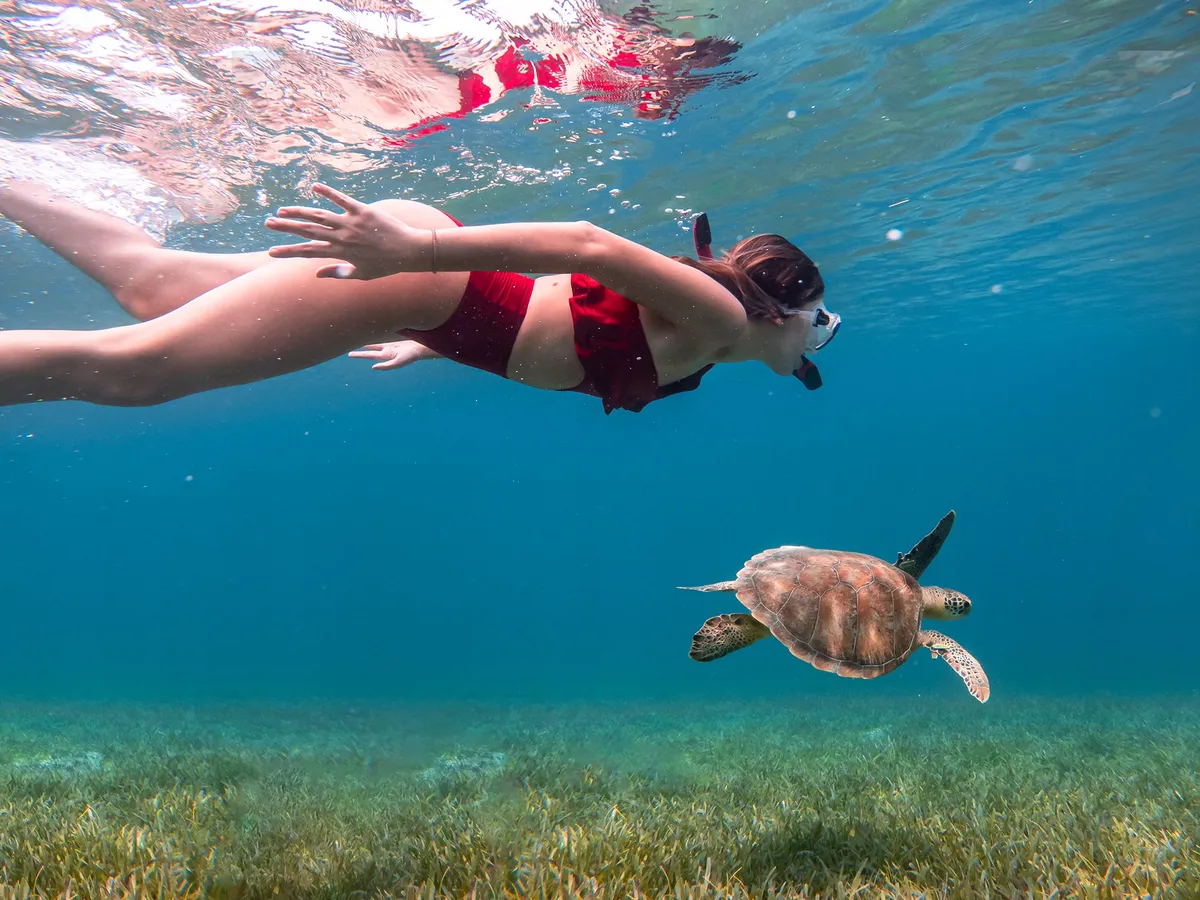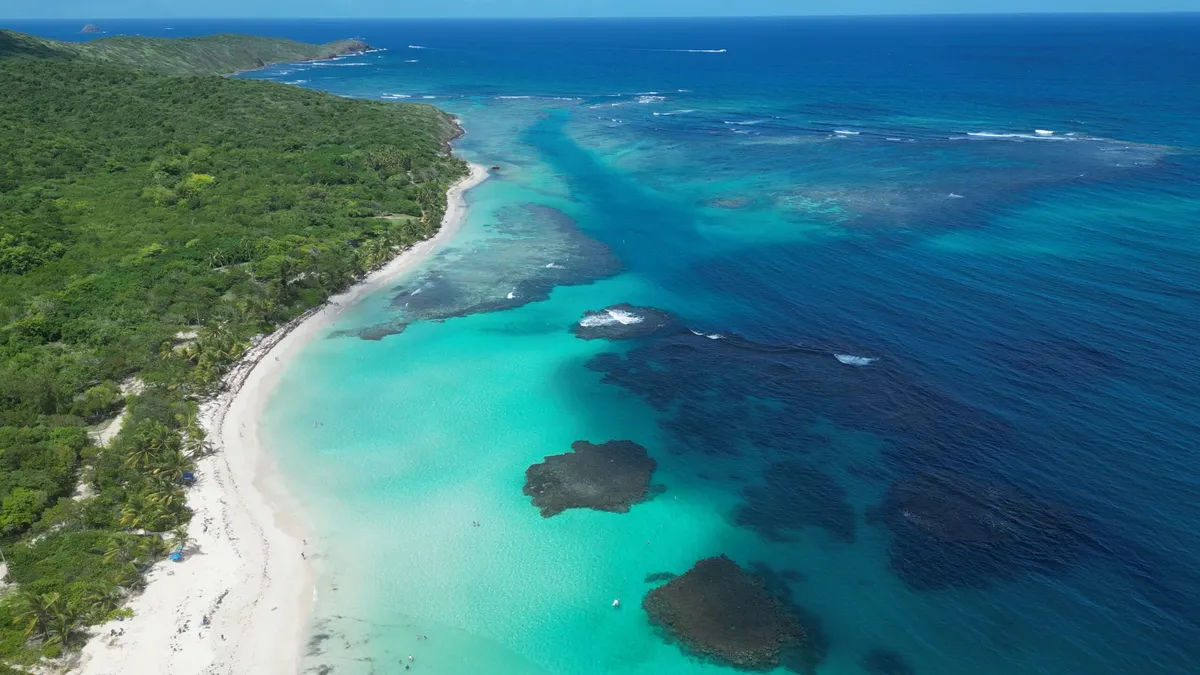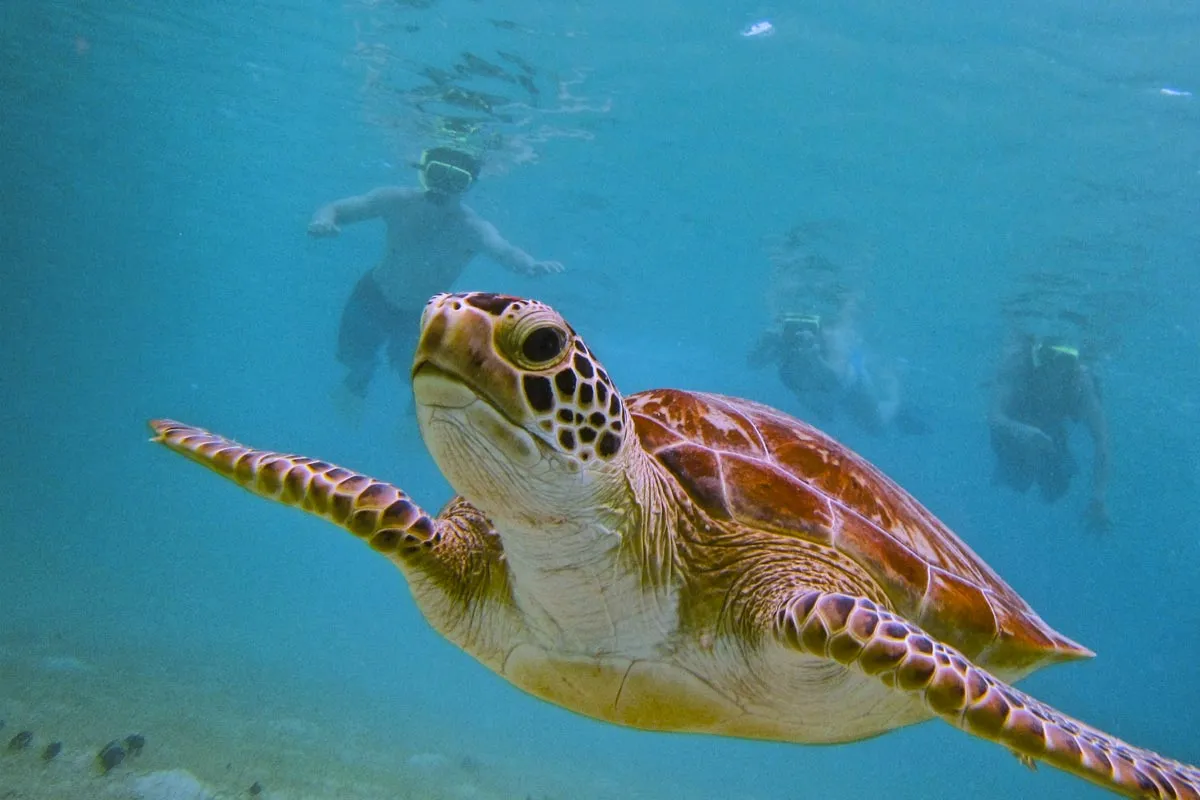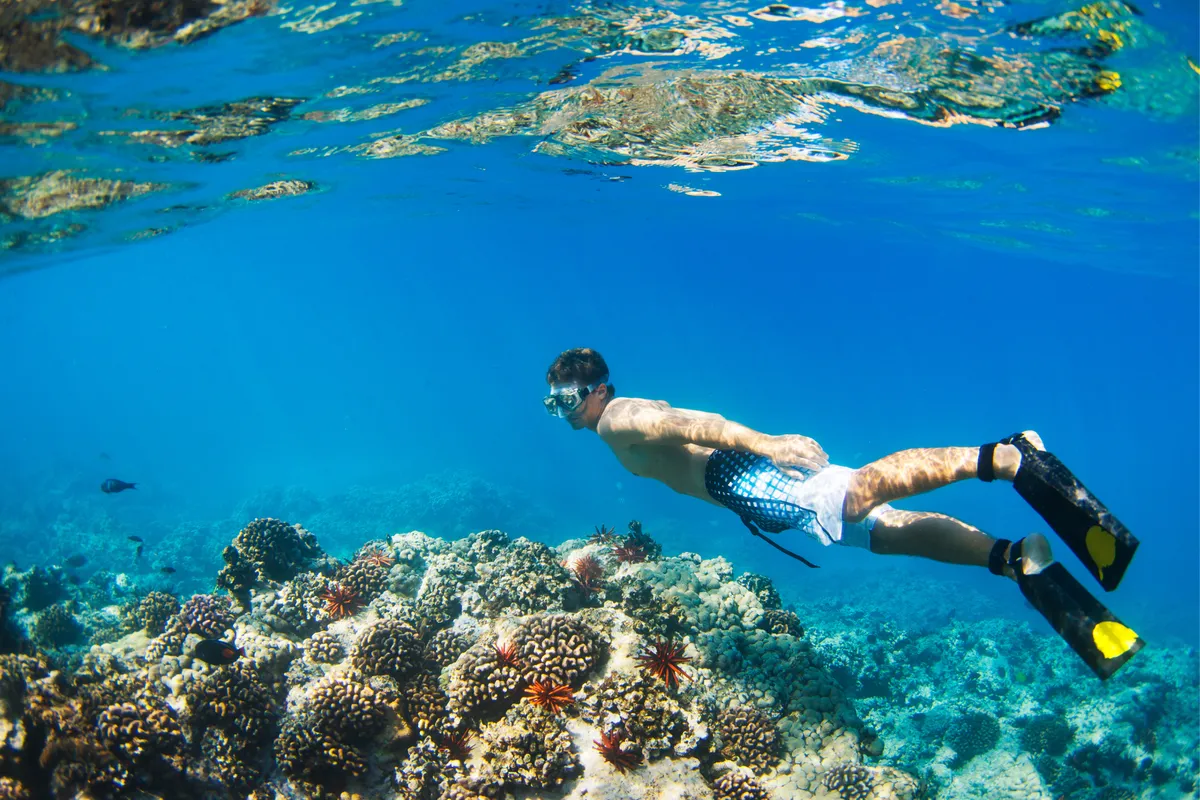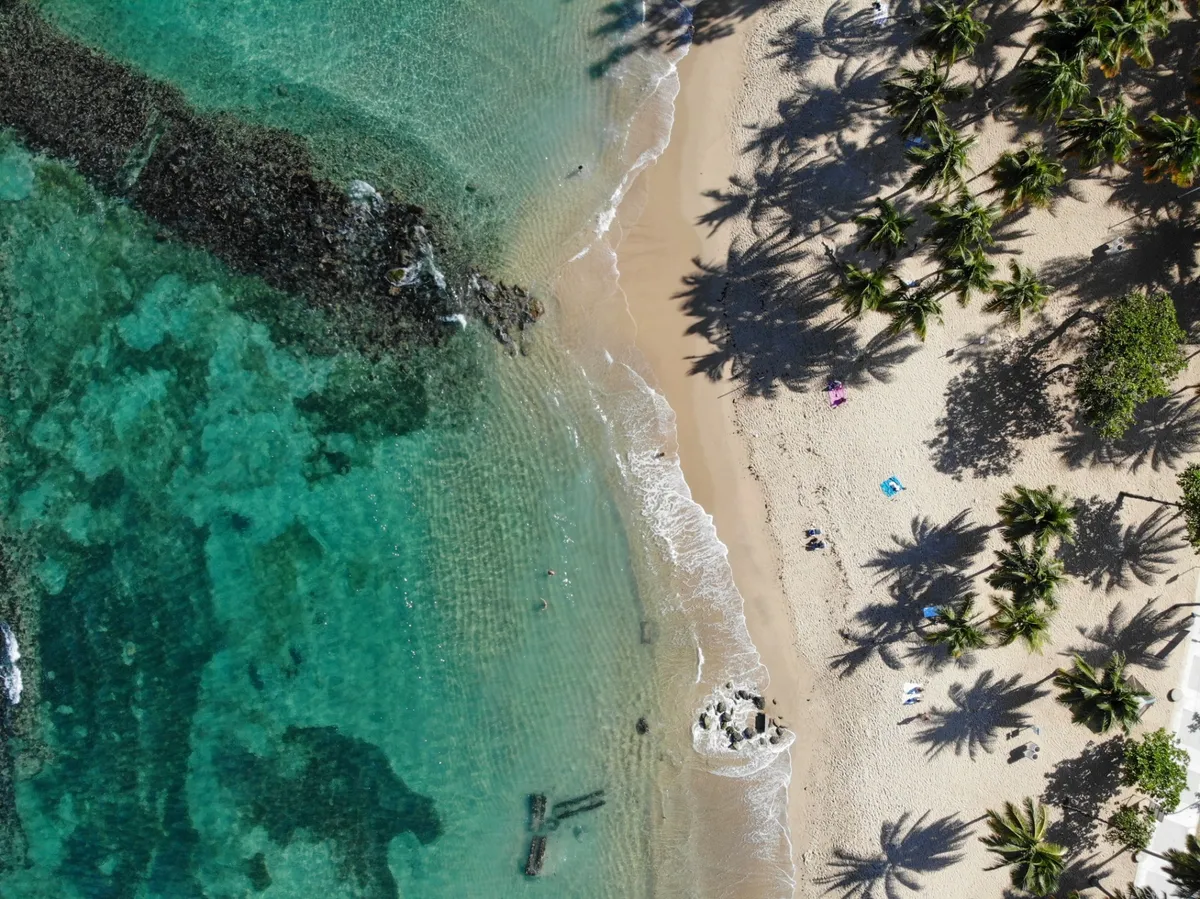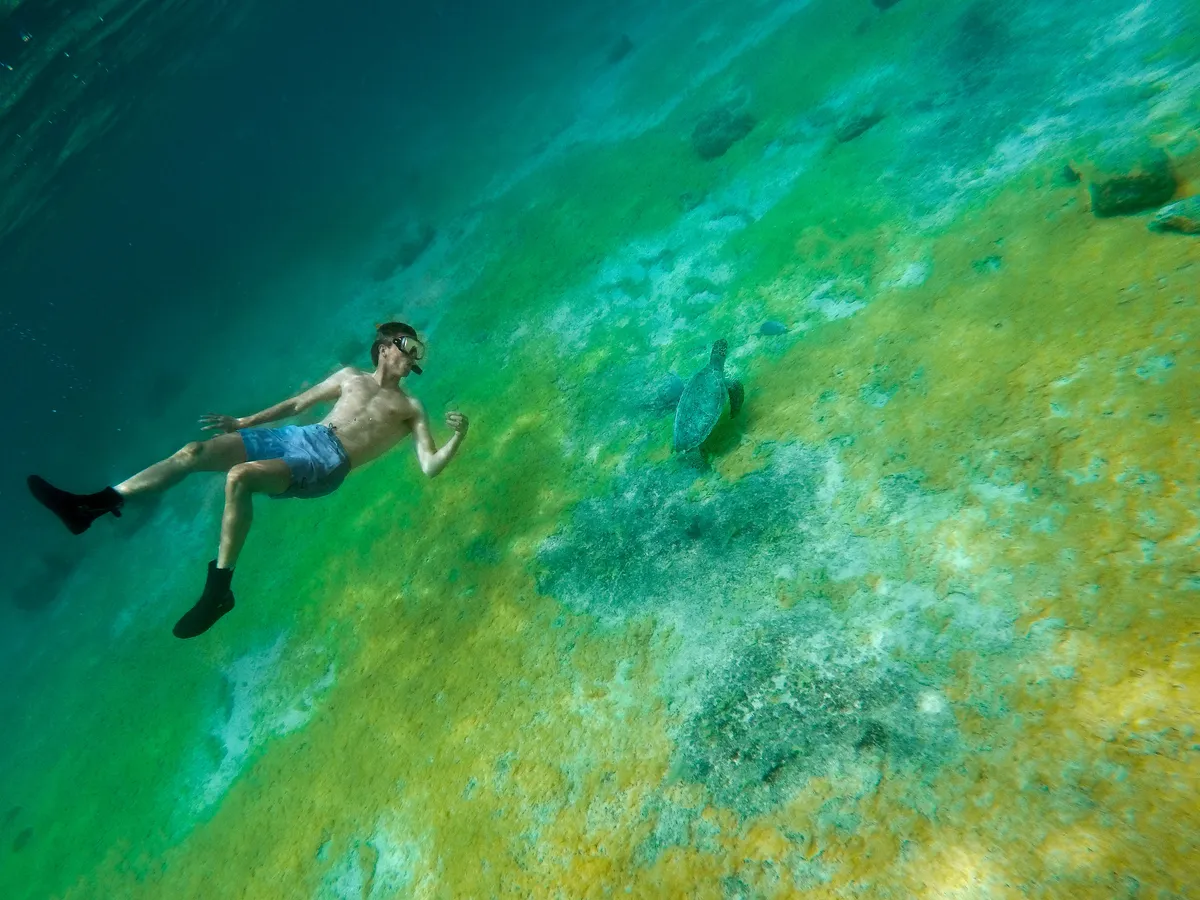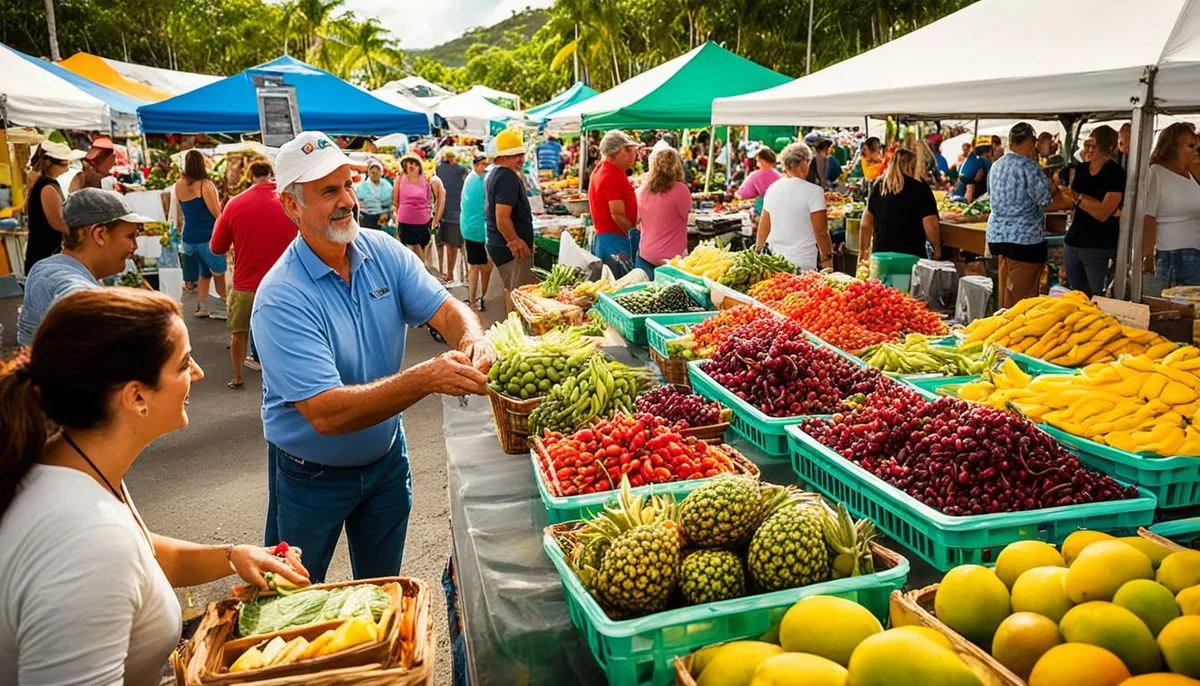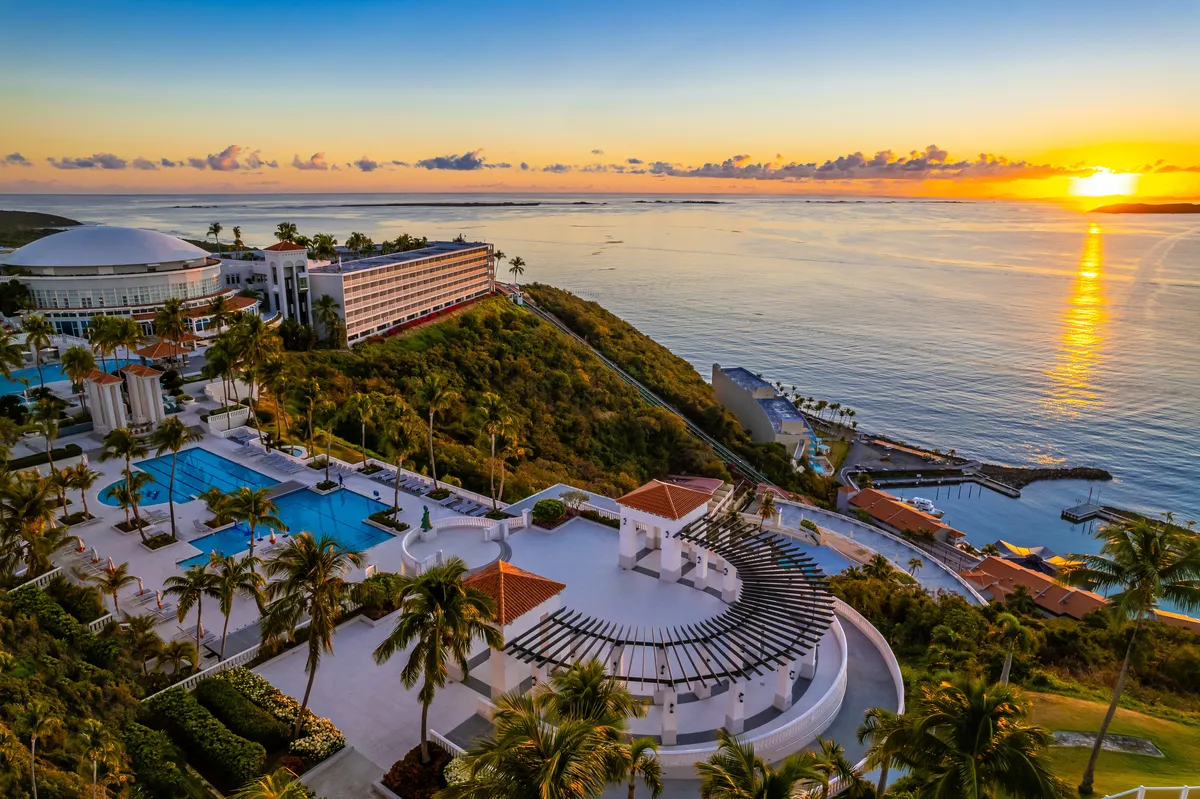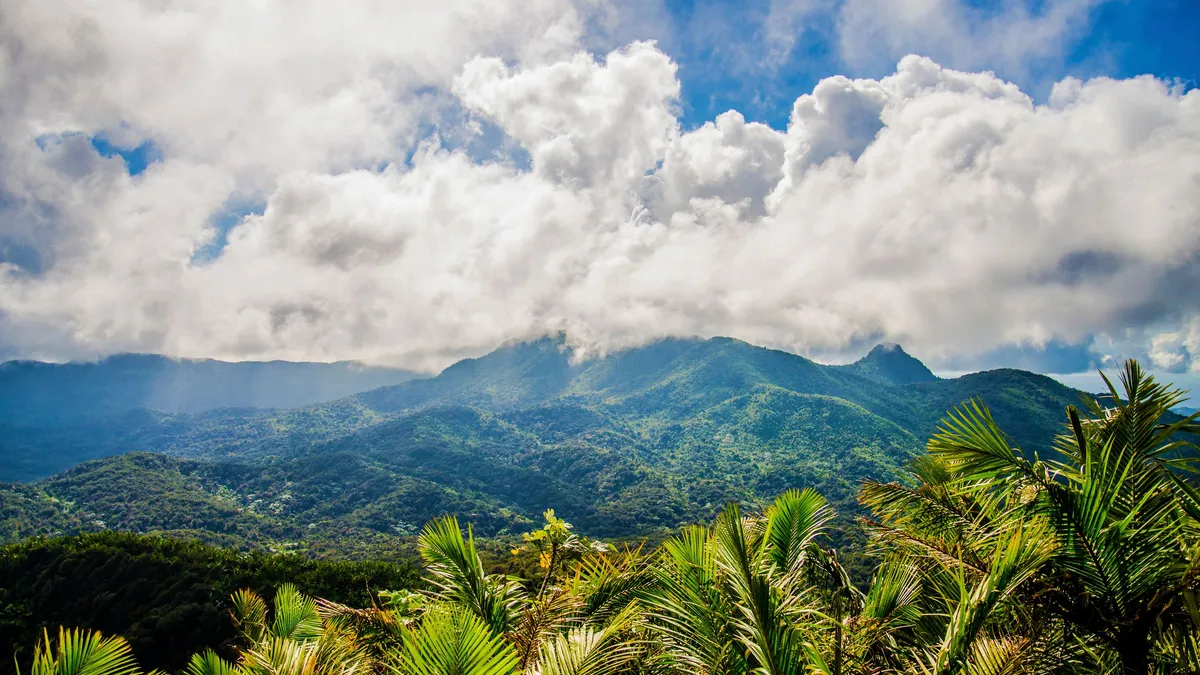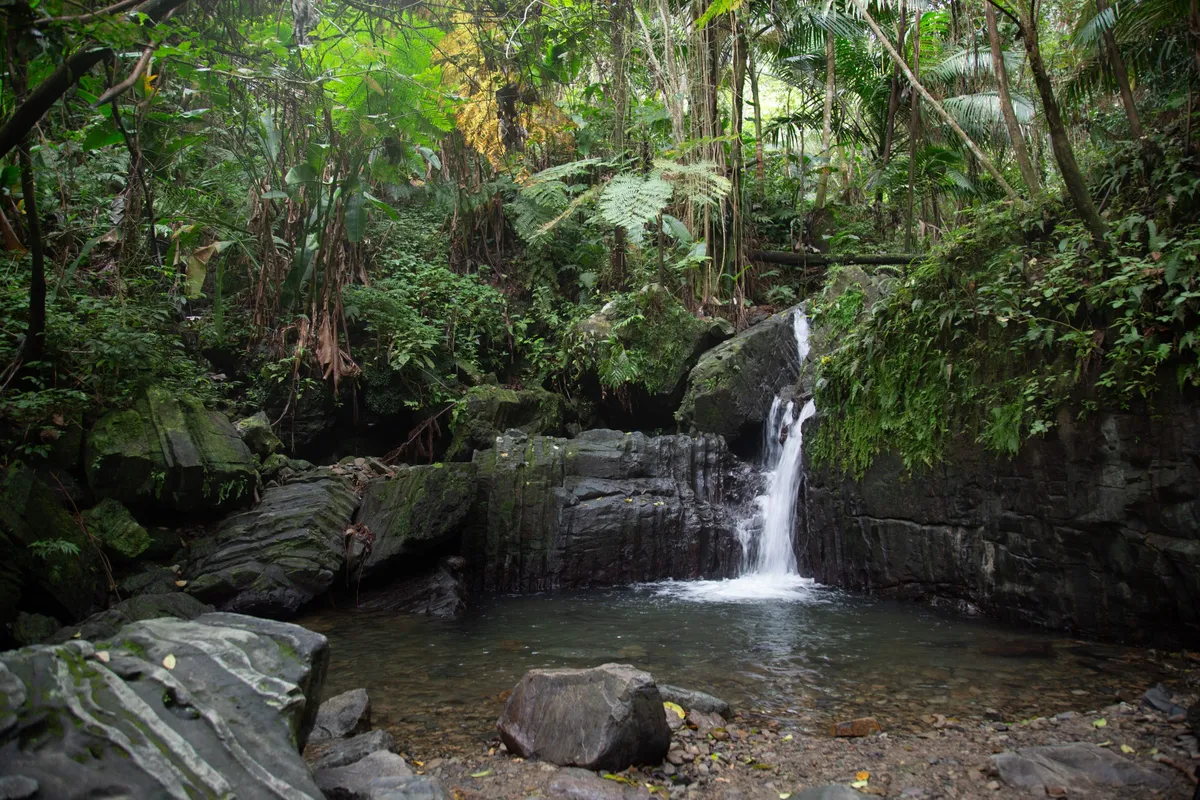If you have ever dreamed of floating weightlessly above crystal-clear Caribbean waters while sea turtles graze peacefully below, you will find that snorkeling in Puerto Rico delivers that magic in spades. Picture this: you’re at Tamarindo Beach on Culebra Island, and the water is so transparent you can spot the dark shapes of turtles from the shore before you even put on your fins. Within minutes of entering the water, you are surrounded by these ancient creatures, making you feel like a welcome guest in their underwater neighborhood. This archipelago, particularly its outer islands of Culebra and Vieques, offers reef systems and marine encounters that rival any top-tier Caribbean destination. This guide will show you exactly how to experience the best of it. We’ve compiled insights from countless travelers, combined with extensive research and firsthand knowledge, to help you plan the perfect underwater adventure while protecting these fragile ecosystems for generations to come.
Quick Planning Guide for Snorkeling in Puerto Rico
Let’s get straight to what you need for trip planning. Here are the Puerto Rico snorkeling spots that consistently impress visitors:
- Best Overall Experience: Culebra Island takes the crown with world-class reefs, exceptional water clarity, and abundant wildlife everywhere you look.
- Best for Sea Turtle Encounters: Tamarindo Beach on Culebra is your guaranteed turtle spot, with protected seagrass beds where these gentle giants feed all day. Mosquito Pier on Vieques is a close second for turtle sightings.
- Best for Beginners and Families: Escambron Beach in San Juan offers calm, protected waters with easy shore access—perfect for your first time snorkeling. Tamarindo Beach also works brilliantly for novices due to its shallow, peaceful conditions.
- Best Catamaran Day Trip: An excursion to Icacos Island from Fajardo provides that classic all-inclusive Caribbean vibe with gorgeous beaches and accessible snorkeling.
- Best Mainland Shore Snorkeling: Steps Beach in Rincón is spectacular, but with a critical caveat: it is strictly a summer destination. Winter swells transform this area into a paradise for expert surfers, not snorkelers.
- Most Unique Spot: La Parguera Nature Reserve on the southwest coast lets you explore mangrove channels and a completely different coastal ecosystem.
Quick Comparison of Top Snorkeling Spots
| Spot Name | Location | Best For | Accessibility | Skill Level |
| Carlos Rosario Beach | Culebra | Healthy coral reefs | 20-min hike or boat | Intermediate |
| Tamarindo Beach | Culebra | Sea turtles and rays | Drive-up / Easy | Beginner |
| Mosquito Pier | Vieques | Large marine life | Drive-up / Scramble | Advanced |
| Steps Beach | Rincón | Elkhorn coral garden | Shore entry | Beginner (summer only) |
| Escambron Beach | San Juan | Convenience and fish | Shore entry | Beginner |
Culebra and Vieques: Puerto Rico’s Snorkeling Crown Jewels
While mainland Puerto Rico has some solid snorkeling, there is a noticeable jump in quality on the outer islands of Culebra and Vieques. These spots consistently earn rave reviews for their superior water clarity, healthier reefs, and abundant wildlife, placing them in world-class territory. If snorkeling tops your must-do list, visiting at least one of these islands is essential.
The secret to their success is protection. Most celebrated spots here are located within government-protected areas like the Luis Peña Channel Natural Reserve in Culebra and the Vieques National Wildlife Refuge. These conservation zones, with “no-take” fishing policies, have allowed marine ecosystems to flourish, creating the vibrant underwater landscapes you will explore.
Snorkeling in Culebra: A Caribbean Underwater Paradise
Located about 17 miles off the mainland’s east coast, Culebra is frequently called the best snorkeling destination in all of Puerto Rico—a well-earned reputation. The island’s legendary water clarity is partly due to having no rivers, which means no sediment runoff to muddy the water, even after heavy rain. Most premier snorkeling beaches fall within the protected Luis Peña Channel Natural Reserve, fostering an incredibly healthy marine environment.
1. Carlos Rosario Beach – The Best Reef in Culebra
For serious snorkelers, Carlos Rosario Beach represents the holy grail. This reef stretches extensively with deeper sections that feel more like scuba diving, offering exploration opportunities you won’t find in shallower spots. The coral and sea life here are exceptionally abundant, though you will notice some bleaching in certain areas. An insider tip from experienced snorkelers: swimming past the damaged sections reveals more vibrant, healthy corals teeming with fish further out.
What makes this spot special is its variety—deeper coral formations to the right and shallower gardens to the left, giving you options based on your comfort level. The trade-off for this pristine location is accessibility. It typically requires a 15-20 minute hike from the Flamenco Beach parking lot, though recent reports suggest trail limitations make a boat or water taxi more reliable. A pro tip from seasoned visitors: wear a rash guard, as jellyfish can appear during certain seasons.
2. Tamarindo Beach – Guaranteed Sea Turtle Encounters
If wildlife encounters are your priority, Tamarindo Beach delivers consistently. This spot has earned its reputation for high-probability encounters with green sea turtles and southern stingrays. Travelers regularly report spotting five to ten turtles during a single visit, with many calling it an absolute must-do experience.
Here’s what you will find: the left side of the bay has seagrass where turtles and rays congregate, while the right side features vibrant coral systems with dozens of tropical fish species. This combination creates a diverse and exciting snorkeling experience perfect for beginners and families, thanks to calm, shallow waters and easy car access. The only downside is its growing popularity, so expect company, especially during peak season.
3. Flamenco Beach – Snorkeling at a World-Famous Beach
While Flamenco Beach is justly famous for its perfect crescent of white sand and iconic graffiti-covered tanks, it also offers excellent snorkeling if you know where to look. The accessible reef just left of the main entrance has seen heavy use over the years and doesn’t represent the area’s best underwater life—a detail many visitors miss.
For truly vibrant snorkeling, head to the far right (east) end to an area locals call “Shark Cages” or “Muellecito.” Here, a much healthier reef system extends right to the shore. The entry point is between two rows of old concrete pilings, with the best exploration around these structures and to the right. While the main beach is perfect for beginners, the far right side can experience stronger currents, requiring caution.
4. Melones Beach and Culebrita – Off-the-Beaten-Path Gems
If you crave quieter spots, Melones Beach offers an easily accessible, drive-up location known for its beautiful coral and sea fan gardens. The key is to enter the water and swim right along the rocky coastline where the best marine life resides.
For the ultimate snorkeling escape, the tiny offshore island of Culebrita is unparalleled. You will need to charter a water taxi or private boat, but your reward is near-total seclusion and some of the region’s most pristine reefs. Tortuga Beach on Culebrita is particularly impressive, where sea turtles often feed on seagrass in the calm bay. Getting there requires planning and extra expense, but for many travelers, the pristine solitude makes it worthwhile.
Snorkeling in Vieques: Wild Reefs and Unique Piers
Vieques, Culebra’s larger and wilder sibling, delivers a distinctly different but equally compelling snorkeling experience. A vast portion of the island sits within the Vieques National Wildlife Refuge, a legacy of former U.S. Navy use. While that history remains controversial, it had the unintended consequence of protecting marine ecosystems from development for decades, resulting in remarkably preserved reefs.
1. Mosquito Pier (Rompeolas) – An Advanced Snorkeler’s Playground
Mosquito Pier is not a typical beach—it’s a mile-long jetty the Navy built but never completed. The real adventure happens beneath the surface among massive pilings that act as an artificial reef. The water here is significantly deeper than most shore-entry spots, reaching 50 feet in places, which attracts stunning larger marine life. This ranks among the best places in Puerto Rico to spot spotted eagle rays, large tarpon, barracuda, and sea turtles gliding through the pier pillars.
Access involves scrambling down a rocky embankment or, for the adventurous, jumping from the pier itself. Due to the depth and potential for strong currents and surf, this location is strictly for confident, experienced swimmers only. For beginners or families, the adjacent Rompeolas Beach (also called Starfish Beach) offers much calmer, shallower, and safer conditions at the pier’s base. This spot delivers incredible marine encounters but demands respect and strong swimming skills.
2. Bahía de la Chiva (Blue Beach) – A Picture-Perfect Caribbean Bay
Consistently ranked among Vieques’ most beautiful beaches, Bahía de la Chiva sits within the wildlife refuge, boasting calm, brilliant turquoise water and excellent snorkeling, particularly around the small cay (Isla Chiva) in the middle of the bay.
To access the best snorkeling with the shortest swim, use parking areas marked #7, #8, or #10-11. From spots 10 and 11, you can swim out to the cay. Be aware that this area has a high concentration of sea urchins, so water shoes or extreme caution with foot placement is highly advised. The beach itself is stunning, but those urchins mean you need to watch where you step.
3. Punta Arenas (Green Beach) – The Effortless Drift Snorkel with a View
Located on the far western tip of Vieques, Punta Arenas delivers a unique snorkeling experience with magnificent views back toward the main island and El Yunque rainforest. The prevailing current often allows for an easy “drift snorkel,” where you enter at one point and let the gentle current carry you along the reef with minimal effort.
Guided tour accounts highlight this as a prime location for spotting sea turtles in underwater seagrass pastures and discovering historical artifacts like the submerged ruins of an old sugar cane railroad pier. Reaching Green Beach is an adventure itself—the access road is notoriously rough and unpaved, requiring a high-clearance 4WD vehicle. Many car rental agreements on Vieques explicitly forbid taking standard vehicles on this road, so plan accordingly or book a tour.
4. Esperanza Sugar Pier and Pata Prieta (Secret Beach) – Local Favorites
In the charming south-coast town of Esperanza, the ruins of an old sugar pier create another fantastic snorkeling site. The decaying pilings shelter a wide variety of fish, and it is a popular spot with locals. One snorkeler reported a memorable encounter with a massive goliath grouper here—the kind of unexpected moment that makes snorkeling magical.
For those seeking true seclusion, Pata Prieta (Secret Beach) is a tiny, protected cove within the wildlife refuge. This hidden gem offers a tranquil atmosphere and excellent snorkeling along the rocky outcrops framing both sides of the beach. It takes effort to find, but that is precisely why it stays so peaceful.
Mainland Puerto Rico Snorkeling: A Regional Guide
While Culebra and Vieques represent the pinnacle, the main island offers numerous accessible and rewarding spots perfect for travelers. The experience here is more about convenience and day-trip suitability, but several standout locations deserve your attention. A key factor is the island’s geography: the north and east coasts face the rougher Atlantic Ocean, while the south and west coasts border the calmer Caribbean Sea, often resulting in better visibility and more tranquil waters, especially during winter months.
The East Coast Hub: Fajardo and Its Cays
Fajardo functions less as a shore snorkeling destination and more as the essential logistical hub for all east coast marine activities. Its marinas are the primary departure points for ferries to Culebra and Vieques, plus popular catamaran tours to the nearby cays of the Cordillera Reefs Nature Reserve.
The quintessential Fajardo snorkeling experience is a catamaran day trip to Icacos or Palomino Island. These excursions are perfect for travelers wanting a relaxed, all-inclusive day on the water, typically featuring lunch, drinks, and a festive atmosphere alongside snorkeling. The waters around these cays are generally shallow, clear, and calm, making them ideal for beginners and families. The trade-off is being on a tour schedule, but for many, the convenience outweighs the lack of independence.
For those who prefer the mainland, Seven Seas Beach offers the most reliable option in the Fajardo area. The best snorkeling is found by swimming out from the rocky point on the far-right side of the beach, where a reef system spans much of the bay.
The West Coast Wonder: Rincón’s Seasonal Secret
Rincón, on Puerto Rico’s west coast, holds one of the mainland’s most spectacular snorkeling secrets, but it comes with a critical warning: Rincón snorkeling is a summer-only activity. During the winter months (roughly October through April), this area transforms into a world-renowned surfing destination with powerful Atlantic swells that create extremely dangerous conditions for snorkelers.
When the seas calm in the summer, Steps Beach within the Tres Palmas Marine Reserve becomes a snorkeler’s paradise. The main attraction is one of the largest and healthiest elkhorn coral gardens in the entire Caribbean, easily accessible directly from the shore. You can spend hours floating over these magnificent, branching coral structures that provide habitat for sea turtles, lobsters, and large schools of fish like Blue Tangs and angelfish. Guided tours are highly recommended for first-time visitors.
San Juan’s Urban Oasis: Escambron Beach
For travelers staying in the San Juan metro area, Escambron Beach provides a surprisingly vibrant and incredibly convenient snorkeling experience. Located adjacent to Old San Juan, this beach is protected from often-rough Atlantic waves by rock formations, creating a calm, pool-like swimming area.
This protected cove is part of a marine park where fish are abundant and accustomed to swimmers, often allowing for very close encounters. It is an excellent spot for beginners and families to practice their skills in a safe environment. Experienced visitors recommend arriving early in the morning when the water is calmest and clearest, before the afternoon crowds arrive. While it gets busy, its popularity ensures easy access, facilities, and safety.
The Southern Coast and Other Gems
The southern coast, facing the Caribbean Sea, offers several unique snorkeling destinations known for calm waters.
- La Parguera Nature Reserve: In Lajas, this reserve provides a different snorkeling environment where you can explore a network of mangrove coves, channels, and shallow keys in brilliantly turquoise water. The area is also known for its resident manatee population, offering a rare chance to spot these gentle giants.
- Gilligan’s Island (Cayo Aurora): Near the town of Guánica, this spot is fantastic for families with young children. A short ferry ride takes you to a small cay surrounded by shallow, crystal-clear water that feels like a giant natural swimming pool—perfect for introducing kids to snorkeling.
Planning Your Puerto Rico Snorkeling Trip: Tours, Gear & Logistics
Guided Tours vs. DIY: Which is Right for You?
One of your first decisions is whether to book a guided tour or explore independently. Both approaches have significant advantages depending on your budget, experience level, and desired flexibility.
- Guided Tours work best for accessing remote, boat-only locations like Culebrita, Icacos, and the best Vieques reefs. They provide all necessary equipment, professional safety oversight, and expert guides. This makes them ideal for beginners or anyone seeking a convenient, hassle-free day.
- DIY Shore Snorkeling offers maximum flexibility and is more budget-friendly. For experienced snorkelers with a rental car, exploring drive-up beaches like Tamarindo or Steps Beach allows you to snorkel on your own schedule.
| Feature | Guided Tour | DIY Shore Snorkel |
| Cost | Higher ($70-$150+ per person) | Lower (gear rental only) |
| Access | Remote reefs, cays | Drive-up beaches |
| Convenience | High (all-inclusive) | Low (requires planning) |
| Flexibility | Low (fixed schedule) | High (your own schedule) |
| Best For | Beginners, non-swimmers, groups | Experienced snorkelers, budget travelers |
Vetted Tour Operators: Local Recommendations
Choosing a reputable tour operator significantly enhances your snorkeling experience. These companies consistently earn praise for their professionalism, local knowledge, and commitment to small-group, eco-friendly tours.
Culebra:
- Culebra Divers: Established in 1987, this professional dive shop offers small-group boat tours to the island’s best reefs and provides high-quality gear rentals.
- Snorkel With Locals: Run by a Culebra native and certified instructor, this operator offers a highly personal and enthusiastic approach, making tours feel like an adventure with a knowledgeable local friend.
Vieques:
- Abe’s Snorkeling & Biobay Tours: One of the most recommended companies on Vieques, Abe’s offers a wide range of tours, including unique kayak-and-snorkel trips.
- Salty Spirit: Highlighted for its quality local guides whose expertise helps guests find sea turtles and other wildlife.
Fajardo (for cays/islands):
- Snorkeling Puerto Rico (Innovation Tours): Noted for excellent customer service and patience with beginners and children, making them a top family-friendly choice for Icacos Island tours.
- Pirate Snorkeling Shack: A family-owned business emphasizing eco-friendly practices and offering a more intimate alternative to larger catamaran tours.
Renting Snorkel Gear: Costs and What to Look For
For DIY snorkeling, renting gear is easy and affordable. A complete set including a mask, snorkel, and fins typically costs around $25 for a 24-hour period.
When selecting gear, quality matters for a comfortable experience. Choose a mask with a soft “silicon skirt,” as it creates a much better seal to prevent leaks. For those who wear glasses, many rental shops offer prescription masks for a small additional fee.
The Best Time of Year for Snorkeling in Puerto Rico
While snorkeling is possible year-round thanks to warm water, conditions vary by season. The best overall time for snorkeling in Puerto Rico is during the dry season from December to April. This period generally offers the sunniest weather, calmest seas, and best underwater visibility.
The shoulder season from April to August can also be excellent, with often very calm seas, though afternoon rain showers are more common. Be cautious during the peak hurricane season from August to October.
Remember regional variations. The west coast (Rincón) is best visited in summer when large winter swells subside. Water temperatures remain comfortable year-round, ranging from about 77°F (25°C) in winter to 84°F (29°C) in late summer.
Safety and Responsible Snorkeling in Puerto Rico
Ocean Safety: Respecting the Water
- Rip Currents: These powerful channels of water flowing away from shore are a serious hazard. If caught in one:
- Stay calm. Do not fight the current.
- Swim parallel to the shoreline to escape its pull.
- Once free, swim diagonally back toward shore.
- Before you go, check the daily rip current forecast from the National Weather Service for San Juan.
- Other Hazards:
- Boat Traffic: Stay vigilant in popular areas. A brightly colored float or dive flag increases your visibility.
- Sea Urchins: These are common in rocky areas. Never stand on rocks or coral.
- Shallow Reefs: Unexpected swells can push you onto shallow coral. Always maintain a safe distance and snorkel with a buddy.
Protect the Reefs: Your Role as a Responsible Snorkeler
- Use Reef-Safe Sunscreen (Non-Negotiable): This is one of the most significant actions you can take. Common sunscreens contain chemicals like oxybenzone and octinoxate, which are proven to cause coral bleaching. Puerto Rico has banned the sale of these harmful sunscreens. Use only mineral-based sunscreens with zinc oxide or titanium dioxide. Better yet, wear a UV-protective rash guard to reduce your sunscreen needs altogether.
- The Golden Rules of Reef Etiquette:
- Do not touch, stand on, or kick coral. Coral is a fragile living animal.
- Do not feed the fish. It disrupts their natural behaviors and harms their health.
- Leave no trace. Pack out everything you bring in.
For more information, consult resources from the Puerto Rico Department of Natural and Environmental Resources (DRNA) and the NOAA Coral Reef Conservation Program.
Snorkeling in Puerto Rico offers a diverse and captivating underwater world for every traveler, from first-timers to experienced ocean explorers. The outer islands of Culebra and Vieques are in a class of their own, with world-class reef systems and wildlife encounters that become trip highlights. The mainland complements these jewels with convenient and beautiful sites, from the urban oasis of Escambron to the unique summer reefs of Rincón.
Successful planning hinges on understanding the island’s geography and choosing locations that match your skill level. These reefs are a fragile natural treasure, offering a window into breathtaking beauty. By visiting with respect, practicing ocean safety, and making conscious choices like using reef-safe sunscreen, you will create lifelong memories while helping to steward this incredible ecosystem. The magic is waiting just below the surface, ready for you to discover.
Read more:
